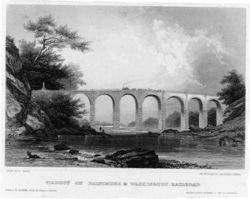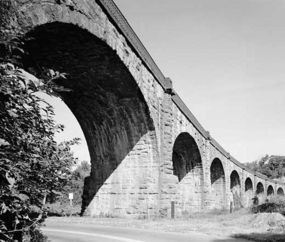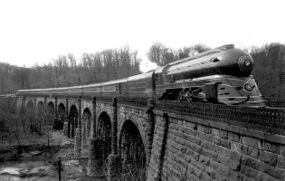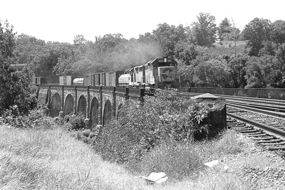Thomas Viaduct
| Thomas Viaduct | |
|---|---|
 Thomas Viaduct ca. 1858 | |
| Official name | Thomas Viaduct |
| Carries | CSX Transportation
2 Tracks |
| Crosses | Patapsco River
Patapsco Valley |
| Locale | Elkridge, Maryland |
| Maintained by | CSX Transportation |
| Design | Arch bridge |
| Longest span | 58 feet (18 m) |
| Total length | 614 feet (187 m) |
| Width | 26 ft 4 in (8 m) |
| Clearance below | 59 feet (18 m) |
| Opening date | July 4, 1835 |
The Thomas Viaduct spans the Patapsco River and Patapsco Valley between Relay and Elkridge, Maryland. Building of the bridge commenced on July 4, 1833 and was completed on July 4, 1835, it is the first multi-span masonry railroad bridge in the United States and the first to be built on a curve. The Thomas Viaduct was the largest bridge in the nation in its day and today it remains the world's largest bridge of its kind.[1], as well as the world's oldest multiple arched stone railroad bridge. It was named for Philip E. Thomas, the first president of the Baltimore and Ohio Railroad (B&O). Until after the American Civil War, the B&O was the only railroad into Washington, thus the Thomas Viaduct was essential for supply trains to reach the Union's capitol during that conflict. To prevent sabotage, the bridge was heavily guarded by Federal troops stationed along its length. The Thomas Viaduct is now owned and operated by CSX Transportation and still in use today making it one of the oldest railroad bridges still in service.
Contents
Design
This Roman-arch stone bridge is divided into eight spans. It was designed by Benjamin Henry Latrobe, II, then B&O's assistant engineer, later the chief engineer and built by John McCartney of Ohio under the supervision of Caspar Wever, the railroad's chief of construction. McCartney received the contract after the successful completion of the Patterson Viaduct. The main design problem to overcome was that of constructing such a large bridge on a curve. The design called several for variations in span and pier widths between the opposite sides of the structure. This problem was solved by having the lateral pier faces laid out on radial lines making the piers essentially wedge-shaped and fitted to the 4 degree curve. The span of the viaduct is 612 ft.(187 m) long, each arch about 58 ft.(18 m) with a height of 59 ft.(18.8 m) from the water level to the base of the rail. The width at the top of the spandrels wall copings is 26 ft, 4 in.(8.03 m). The bridge is constructed using rough-dressed Maryland granite ashlar from Patapsco River quarries. A wooden-floored walkway built for pedestrian and railway employee use is four feet wide and supported by cast iron brackets and edged with ornamental cast iron railings. The viaduct contains 24,476 cubic yards (18,713 m³) of masonry and cost $142,236.51 an estimated $276,991,7.36 today[2].
Renovations
In 1929, extensive mortar work on the masonry was carried out and again in 1937. To counteract deterioration of the masonry, the Thomas Viaduct underwent more cosmetic upgrades in 1938 performed by the B&O Maintenance of Way Department. The work consisted primarily to improve facilities for drainage, relocation of loose arch ring stones and the application of a grout mixture to the stone spandrels filling. Nevertheless, the bridge is still indicative of the way in which the B&O track and major structures were put down in the most permanent manner possible. At an unknown date, railing blocks were removed from the north side of the deck and a bracketed walkway added giving more lateral clearance. Little work had been done on the viaduct until the repairs of 1937–1938 which, according to a 1949 report by the Chief Engineer of the B&O, would keep future maintenance to a minimum.
Brief history of the B&O route
The Baltimore and Ohio Railroad (B&O) was one of the oldest railroads in the United States. Construction began on July 4, 1828, the original route followed the Patapsco River to Ellicott's Mills (later renamed Ellicott City.) in 1835 the "Washington Branch" was constructed. This new line branched at Relay, the site of a former post-road hotel and changing point for stage horses. The Relay House served as a hotel until it was replaced by the Viaduct Hotel. The main line was rerouted in 1868 since a flood destroyed the Patterson Viaduct, which previously carried the main line over the Patapsco. Since then, Thomas Viaduct has carried entirely the railroad's freight and passenger traffic between Baltimore, Maryland and Washington, D.C.
During the 1880s–1950s, Thomas Viaduct carried B&O's famed Royal Blue Line passenger trains between New York and Washington, and, until the late 1960s, B&O passenger trains to points west of Washington, such as the Capital Limited to Chicago, Illinois and the National Limited to St. Louis, Missouri. In 1986, CSX acquired the B&O and all of its trackage which included the Thomas Viaduct. With the advent of Amtrak on May 1, 1971, all B&O passenger train service was discontinued, except for local Baltimore–Washington commuter trains, which continue to operate on a daily basis over Thomas Viaduct as MARC's "Camden Line" train service under contract with CSX Transportation.
A testament through time

When the structure was completed a fifteen-foot (4.6 m) obelisk with the names of the builder, directors of the railroad, the architect (engineer) and others associated with the viaduct was erected at the east end in Relay, Maryland, by builder John McCartney. On one side the monument reads: The Thomas Viaduct, Commenced July 4th, 1833 Finished, July 4th 1835. He also celebrated the completed work by having his men kneel on the deck of the viaduct while mock "baptizing" them with a pint of whiskey.
During design and construction, the Thomas Viaduct was nicknamed "Latrobe's Folly" after the designer Benjamin Latrobe, because at the time many doubted that it could even support its own weight. Yet it has proved them all wrong, the Thomas Viaduct survived the great flood of 1868 as well as Hurricane Agnes in 1972, two floods that wiped out the Patapsco Valley and destroyed nearly everything in their path; and to this day it continues to carry 300 ton (270 tonne) diesel locomotives passengers and heavy freight traffic. The Thomas Viaduct remains as impressive today as at it was at its completion. The Thomas Viaduct marked the beginning of major American railway structures, many more were to follow, very few would survive. Even after more than 170 years the Thomas Viaduct still stands to serve not only as a work of art and engineering marvel but as a vital link in U.S. railroad industry.
Historical landmark
The bridge was designated a National Historic Landmark on January 28, 1964, and administratively listed on the National Register of Historic Places on October 15, 1966.
See also
- Patterson Viaduct - one of John McCartney's earlier works.
References and footnotes
- Historic American Engineering Record survey No. HAER MD,14-ELK,1 "Significance" section.
- ↑ Maryland Department of Natural Resources Patapsco Valley State Park. Patapsco Valley State Park History. Retrieved on October 3, 2007.
- ↑ S. Morgan Friedman. Inflation Calculator. Retrieved on October 2, 2007.
External links




